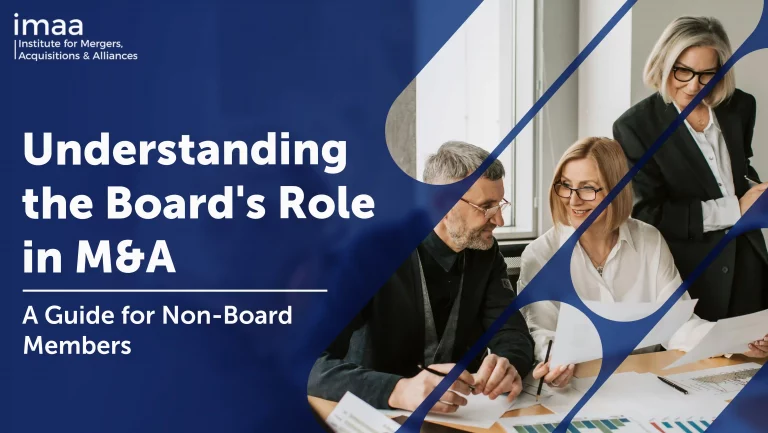
Blog Understanding the Board’s Role in M&A: A Guide for Non-Board Members
- Blog
Understanding the Board’s Role in M&A: A Guide for Non-Board Members
- Nima Noghrehkar

SHARE:
In the complex model of corporate mergers and acquisitions (M&A), the board of directors plays a pivotal role in steering the company towards strategic growth while safeguarding shareholder interests. For non-board members, understanding this role is essential for recognizing how these high-level decisions impact both the company’s trajectory and individual careers. This complete guide covers the board’s involvement in M&A and provides practical insights into how non-board members can effectively engage with and adapt to these processes.
The Strategic Role of the Board in M&A
Decision-Making and Oversight
The board’s involvement in M&A revolves around strategic decision-making and oversight, ensuring that any potential acquisition aligns with the company’s strategic objectives. This involves assessing how proposed acquisitions fit within the broader corporate strategy and overseeing the due diligence processes to manage all associated risks effectively. The board evaluates various aspects of potential deals, including market expansion, financial health, competitive advantage, and cultural fit.
Ensuring Alignment with Corporate Strategy
Evaluating potential M&A activities for strategic alignment is crucial. The board analyzes market conditions, the target company’s strategic fit, and the potential for value creation through synergies. This ensures that M&A activities enhance the company’s position in the market and contribute to long-term strategic goals. The board also considers the implications of each decision, from financial impacts to changes in corporate culture and employee integration.
Governance and Risk Management in M&A
Supervising Due Diligence
A crucial role of the board is to oversee the thoroughness of the due diligence process. This governance role is vital in managing the uncertainties and complexities that accompany M&A activities. Due diligence covers a broad spectrum, from financial audits and legal compliance checks to cultural assessments and operational evaluations. The board ensures that every aspect of the target company is scrutinized to avoid potential pitfalls and liabilities.
Managing Integration and Post-Merger Processes
Post-approval, the board monitors the integration process to ensure it aligns with the company’s strategic objectives. Effective integration is critical in realizing the desired synergies and achieving the intended benefits of the merger or acquisition. The board sets benchmarks and timelines for integration, oversees progress, and intervenes when necessary to redirect efforts or resources, ensuring that the merger delivers the expected value to shareholders and stakeholders.
Enhancing Shareholder Value Through M&A
Strategic Acquisitions
The board must consider each acquisition’s impact on shareholder value. This involves evaluating whether the timing of the acquisition and the price paid maximize returns to shareholders, particularly in a volatile market where strategic timing can significantly influence the outcome of the deal. The board weighs the benefits of immediate financial gains against potential long-term strategic advantages, ensuring decisions align with shareholder expectations and investment goals.
Long-Term Value Creation
The primary goal of the board’s involvement in M&A is to enhance long-term shareholder value. This requires a delicate balance between achieving immediate financial gains and fostering sustainable growth. The board assesses how each transaction will affect the company’s future market position, revenue streams, and competitive standing. They also consider how acquisitions can diversify product lines, enhance technological capabilities, and expand geographic reach.
Responding to an Uncertain World
Navigating Challenges
In 2024, boards face unprecedented challenges due to global instability and regulatory changes. These factors necessitate a board that is not only proactive but also highly strategic in its approach to M&A. Non-board members should be aware of these challenges as they can significantly impact the company’s M&A strategy and execution. Understanding the external pressures that influence board decisions can provide non-board members with a deeper perspective on the complexities of navigating M&A in a turbulent economic environment.
Preparing for Complexity
The increasing complexity of the regulatory environment requires boards to be more diligent and thorough in their oversight of M&A activities. For non-board members, understanding these complexities helps in anticipating how strategic decisions are shaped by external factors and what these decisions mean for the future of the company. It also highlights the importance of regulatory compliance and strategic foresight in planning and executing mergers and acquisitions.
Practical Advice for Non-Board Members
For professionals deeply involved in the M&A process who are not on the board of directors, understanding how to effectively communicate and engage with the board of directors is crucial. This engagement ensures that strategic contributions are recognized, and decision-making is informed by on-the-ground insights.
1. Know the Board's Priorities
Before engaging with the board, it is crucial to understand their priorities and concerns regarding the M&A. Typically, boards are focused on strategic alignment, risk management, shareholder value, and the long-term impact of the acquisition. Align your discussions and reports to address these priorities, emphasizing how your work and insights contribute to these areas.
Action Steps:
- Review board meeting agendas and minutes (what is shared) from past sessions that discussed M&A to gauge the concerns and questions raised by board members.
- Discuss with senior executives who regularly interact with the board to get a sense of the current board sentiment towards M&A activities.
2. Communicate Effectively
When communicating with the board, clarity, conciseness, and relevance are key. Whether in written reports or presentations, ensure your information is tailored to board-level consumption, focusing on strategic insights rather than granular details, unless specifically requested.
Action Steps:
- Prepare executive summaries for detailed reports to give a high-level overview that addresses key strategic, financial, and risk aspects.
- Use visual aids like charts and graphs to summarize complex data and trends during presentations, making it easier for board members to grasp the implications quickly.
3. Facilitate Decision-Making
Your role in facilitating board decision-making is to provide all necessary information that aids their governance and oversight responsibilities. This includes risk assessments, market analyses, potential synergy evaluations, and integration plans post-M&A.
Action Steps:
- Develop scenario analyses to show different outcomes based on varying assumptions, helping the board understand potential risks and benefits.
- Offer recommendations based on your professional expertise and the data collected but ensure these are presented as options rather than directives to maintain respect for the board’s decision-making authority.
4. Seek Feedback
Engaging with the board is a two-way street. Actively seek feedback on the information provided and your role in the process. This not only helps in adjusting your approach if necessary but also in building a relationship based on mutual respect and constructive dialogue.
Action Steps:
- Request feedback through formal channels such as follow-up emails after meetings, or informal channels, depending on the organizational culture.
- Engage in regular check-ins with board liaisons or executive sponsors who can provide insights into board reactions and needs.
5. Build Credibility
Building credibility with the board involves demonstrating expertise, reliability, and alignment with the company’s strategic goals. Consistently delivering accurate and timely information and showing foresight in identifying potential issues or opportunities will position you as a valuable resource.
Action Steps:
- Participate in continuous professional development related to M&A and corporate strategy to keep your skills and knowledge up-to-date.
- Document and share successes and lessons learned from previous M&A activities to showcase your understanding and contribution to the company’s objectives.
Conclusion
Understanding the board’s strategic, governance, and risk management roles in M&A processes is crucial for non-board members. By staying informed, providing feedback, and pursuing professional growth, non-board members can steer the difficulties of M&A effectively, aligning their career development with the strategic objectives of the organization. This guide serves as a comprehensive resource for non-board members to understand and engage with the board’s activities in mergers and acquisitions, fostering a more informed and proactive approach to corporate transformations.
TAGS:


Stay up to date with M&A news!
Subscribe to our newsletter


